Products You May Like
A good campsite is so much more than a place to sleep. It’s a capstone to your day of hiking, a scenic spot where you can sit down, relax, and end a great day on the trail with a great night, watching the sun go down and the stars begin to sparkle. Pitch your tent at one of these top-notch national park sites—like Lower Rae Lake at Sequoia and Kings Canyon National Parks, pictured up top—to see what we mean.
Our Favorite: Snow Creek Camp, Yosemite National Park, California
Scan your brain for the most iconic feature in all of the national park system and Half Dome inevitably comes to mind. To trek up the side of the granite beast is a life-list experience unto itself, but you can’t truly appreciate the 8,839-foot-tall chunk of stone unless you see it, free of crowds, in all hours. That’s why Snow Creek Camp, a flat, wooded, and granite site directly across from Half Dome, earns top billing. Leave the valley floor, linking the Mirror Lake and Snow Creek Trails and climbing 2,700 feet over 5.2 miles to see the granite cycle through the sunset palette as dusk settles. After that, the long-range views deep into Tenaya Canyon make it feel like the park is showing off. And boy is it.
Hidden Valley, Joshua Tree National Park, California
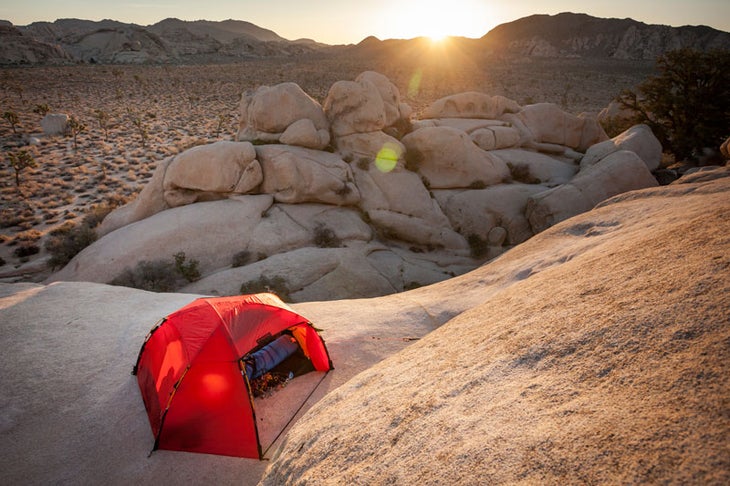
Can’t-miss plan for sussing out a stellar campsite: Go beyond the edges of where campers usually stay; evaluate sites on their merits, not on convenience; the higher you go, the better the views (usually); but don’t waste so much energy that you sleep through a good sunrise. Such a strategy pays off in sites like this in wide-open backcountry just beyond Joshua Tree’s Hidden Valley region. Scramble up the rock formation .5 mile past the western edge of the Hidden Valley camping area and look for a flat spot. Pack in all water (a gallon per person per day). When the morning sun dispels the desert’s evening cool, you’ll know you found the right spot. Trailhead Hidden Valley Season Spring and fall Permit Free; self register at backcountry kiosk
Ford Point, Channel Islands National Park, California

The problem with great beaches is they’re usually mobbed. But not in the Channel Islands, where a two-hour sea crossing keeps the crowds away. At Ford Point, two rocky peninsulas frame the horseshoe-shaped beach, while an offshore reef creates a swell that attracts surfers. Catch the ferry to reach Santa Rosa ($114 per person, round-trip; islandpackers.com), which will drop you off at Bechers Bay Pier. (Note: Pack enough food to accommodate the ferry’s schedule.) From the pier, it’s 9 rugged miles via the Coastal, Wreck, and Ford Point Roads to reach the beach. Pitch your tent above the tideline. Trailhead Bechers Bay Pier Season Mid-August through December to avoid nesting sea lions Permit Free; reserve up to five months in advance
Cracker Lake, Glacier National Park, Montana
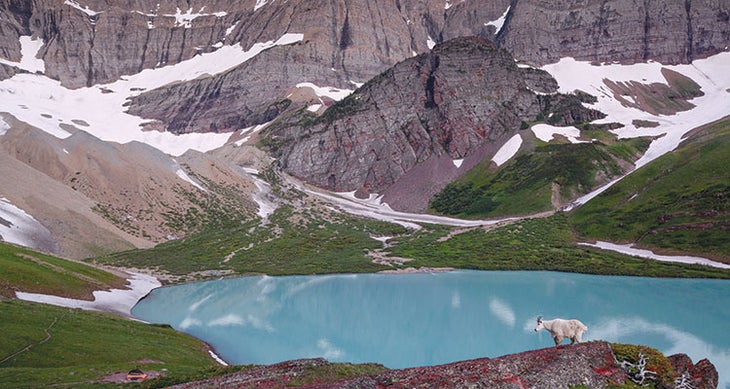
It’s hard to say what you’ll notice first when you reach Glacier’s Cracker Lake—the aqua-blue water or the imposing, gray cliffs that angle thousands of feet upward to the point of 10,003-foot Mt. Siyeh. Three tent sites sit on a grassy slope above the lake’s southeastern shore, offering uninterrupted views of the entire cirque. To reach them, follow the Cracker Lake Trail for 6.3 miles to its namesake, traveling through grizzly habitat, Cracker Flats meadow, and into the deep canyon that drains the lake. The campsites have no tree cover; expect wind. Trailhead Cracker Lake Permit Reserve ahead ($40) or walk-up (iffy); $7/person per night. Season Summer
Redwood Canyon, Sequoia and Kings Canyon National Park, California
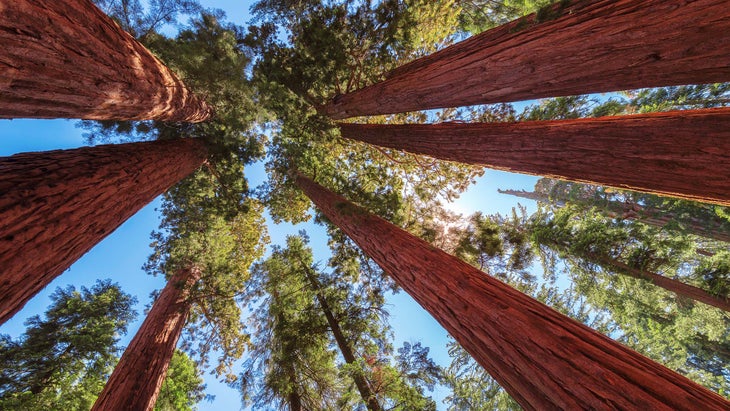
A dispersed camping policy means you can sleep anywhere you like in the heart of this canyon, where the sequoias reach the heavens. But for a campsite with five-star amenities, combine the Sugar Bowl and Hart Tree Trails for a 9.5-mile loop through the park’s largest grove of 300-foot-tall sequoias. The flat spots at the junction where the two trails meet (mile 4.5) will set you up next to Redwood Creek and nestle you in an understory of ferns—you won’t find a softer bed for tree gazing. Trailhead Redwood Canyon Season Summer for wildflowers, fall for solitude Permit $10 per reservation plus $5 /person
Hance Beach, Grand Canyon National Park, Arizona
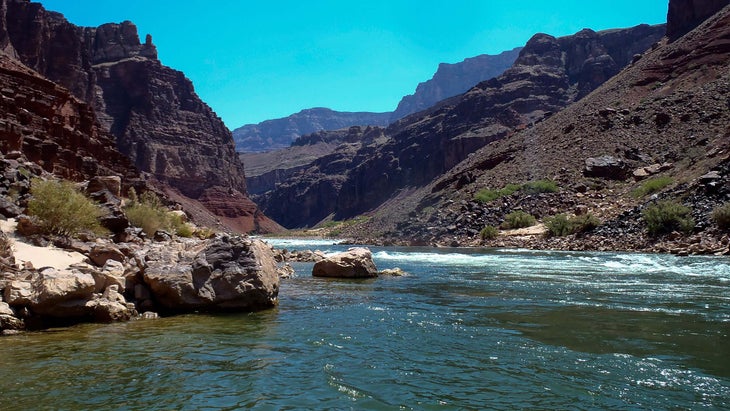
We like to think of the Grand Canyon as a work in progress, subject to the whims and strength of the Colorado River. But there’s one area where it seems like the river saw its work was perfect and declared it done, and that’s Hance Beach. This long stretch of sand forms a wide peninsula alongside Hance Rapids (class 7 to 8 on the Grand Canyon scale), forcing the river to churn through a narrow stretch of boulders. Red sandstone walls rise sharply from the opposite side of the river, broken up occasionally by dark slot canyons, while grasses fringe the beach. Get there by hiking 6.5 miles from rim to river along the New Hance Trail, which many consider to be the toughest trail on the South Rim. Expect scrambles, downclimbs, and some routefinding as you drop through Red Canyon. Make your way back up via an 8.5-mile hike up the Tonto and Grandview Trails, which combine for 4,860 feet of climbing to the rim. Trailhead New Hance Trail has no parking, so you’ll have to park at Moran Point, a mile east on Desert View Road. Shuttle Use park buses from the Grandview trailhead Season Spring, to avoid boaters Permit $10 plus $8/person per night. Reserve up to four months before your visit.
Sheep Pen Gap, Great Smoky Mountains National Park, Tennessee
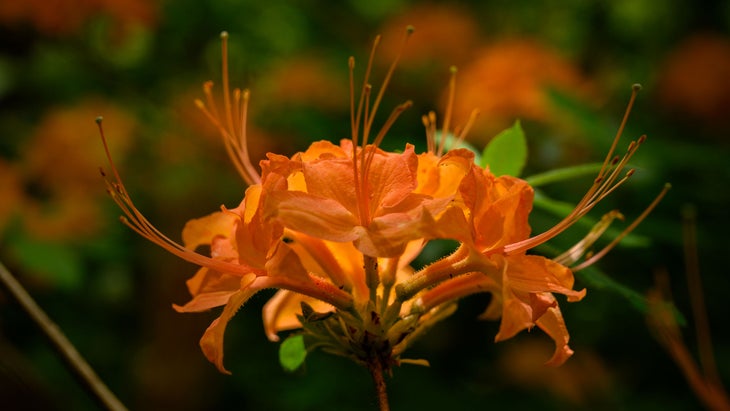
While the origin of the Southern Appalachians’ high-elevation balds is a mystery, one thing’s for sure: Divine intervention could scarcely have made better campsites. And Gregory Bald is best among them, especially when it’s wreathed in pink and orange flame azaleas in mid- to late June. For a quick, 12-mile out-and-back, link the Gregory Ridge and Gregory Bald Trails to Sheep Pen Gap. Trailhead Gregory Ridge Season Summer Permit Reservations required, $4/person per night
Sahale Glacier Camp, North Cascades National Park, Washington
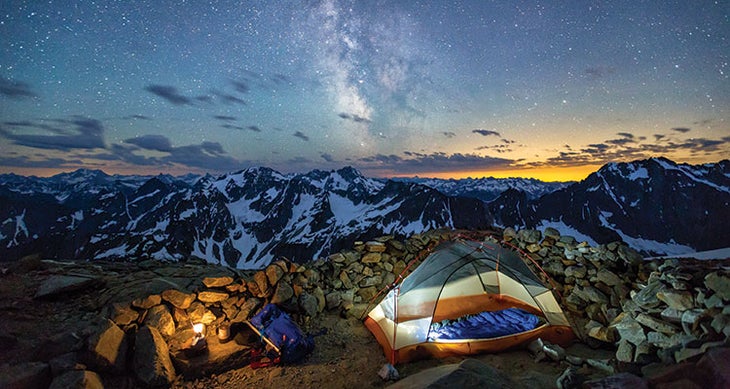
You’re not on top of the world when you reach this rock-protected site at 7,600 feet, but you’ll think you are. Blame the views, which are crowded with mountains the way the night sky is crowded with stars. Or maybe it’s the thundering crashes coming from the large towers of ice that drop from glaciers below you. Or maybe it’s because you’re sleeping on the edge of Sahale Glacier, which offers hours of adventures for those with crampons, ice axes, and ropes. Put it all together and you’ll come to the conclusion: Modest elevation be damned, this is high-alpine camping at its finest. To do it, link Cascade Pass and Sahale Arm Trails for an 11.8-mile out-and-back across meadows and granite talus to this endless view. Trailhead Cascade Pass Season Summer Permit Free; no reservations
Cottonwood Creek, Yellowstone National Park, Montana
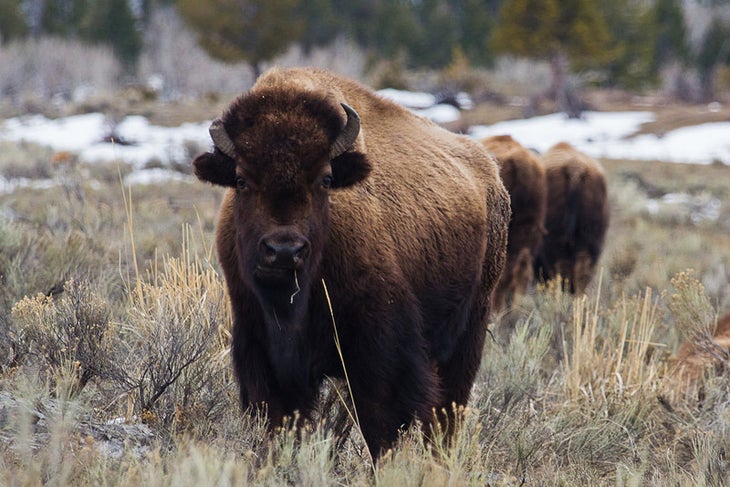
If you consider yourself a lord of the flies, there’s something you should know about Yellowstone. In addition to rainbow, brown, and brook trout, the park’s rivers and lakes teem with the largest inland population of cutthroats in the world. East Cottonwood Camp (campsite 1R2), deep inside the fir-fringed Black Canyon of the Yellowstone River, sits on a wide meadow alongside the Yellowstone River where lunker trout lurk in the deep pools just steps from your tent. Reach the Cottonwood Creek Campsite via a 16.5-mile point-to-point on the Grand Loop Road and arrive at camp (mile 6), after crossing the Yellowstone River (bridge) and Hellroaring Creek (ford). Trailhead Hellroaring Season Summer Permit $3/person per night
Salt Creek Canyon Site 3, Canyonlands National Park, Utah
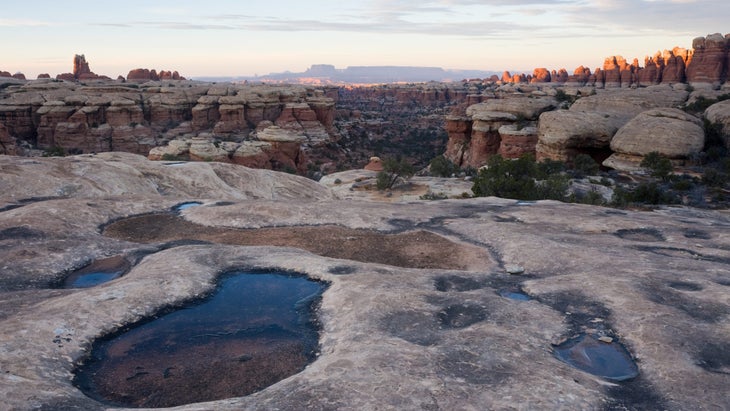
The Salt Creek Trail is like a showroom of arches, cliff dwellings, ruins, and rock art. Add year-round water, and you’ve got some of the finest desert backpacking in the land. Stay at site 3, under a shady oak with views of the canyon walls. Take the long way: 22.5-mile Upper Salt Creek Trail. Trailhead Cathedral Butte and Peakaboo Shuttlecoyoteshuttle.comSeason Spring and fall Permit $36; reserve in advance at recreation.gov.
Hart Lake, Olympic National Park, Washington

A good night starts with a good plan. And the best plans are often made on the fly. That’s how you end up planning to camp at Marmot Lake, but see Hart Lake— smaller, more private, and nestled higher on the mountain—on the map and think, I wonder. It’s the spirit of adventure that costs sweat and scraped shins and pays off in backcountry glory. You’ll be plenty tired to enjoy a long night: Hart Lake lies near the halfway point of a 55.9-mile lollipop loop that traces the Quinalt River, then crosses three passes in a 23.1-mile circumnavigation of 6,400-foot White Mountain. Trailhead Graves Creek Season Mid-summer to fall Permit $5/person per night; walk-in only
Indian Bar, Mount Rainier National Park, Washington
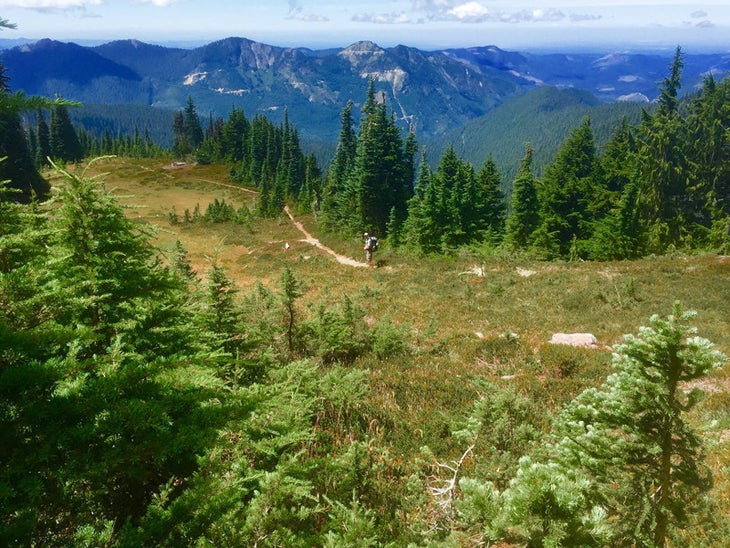
The 93-mile Wonderland Trail is so full of peaks, pines, and mountain streams that it can seem to pass in a wonderful blur. But you’re certain to remember Indian Bar. Nowhere else is the view of Rainier so direct and the creeks tumbling down the rocky cliffs into the Ohanapecosh River so plentiful. If you can’t do the full circuit, try the 14.5-mile out-and-back along the Indian Bar Trail, following the ridgeline of Cowlitz Divide before dropping into the Ohanepecosh River basin. Trailhead Box Canyon Picnic Area Season Early summer for dramatic waterfalls, late summer for wildflowers Permit Free; no reservations
Deer Haven, Badlands National Park, South Dakota
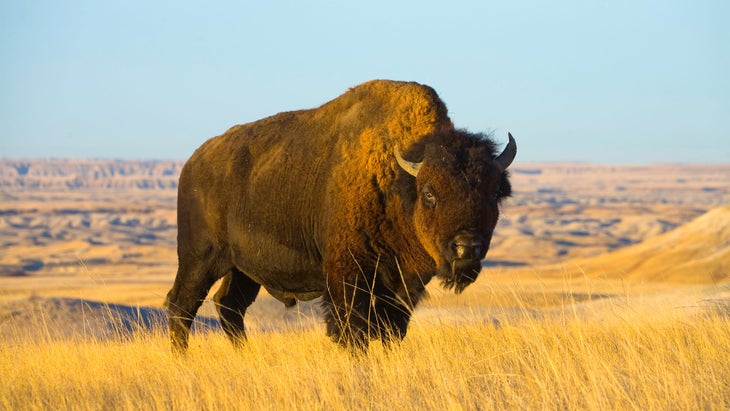
Badlands is home to the largest mixed grass prairie in the U.S., making it an open-air zoo for classic North American game like bighorn sheep and bison. The trailless Sage Creek Loop leads from one rangeland vista to the next, but wait until Deer Haven to set up your tent. Hemmed in by striated badland bluffs, Deer Haven sits high above the plains on a 2,950-foot high uplift that’s dominated by a juniper forest. The animals come for the grass, the trees, and the water, allowing for opportunities to observe interactions between bison herds, coyotes, bighorn and pronghorn sheep, and foxes. Start a two-day, 20-plus-mile lasso loop from the Conata Picnic Area, heading southwest then north around a badland formation to reach Deer Haven (mile 3). Continue northwest into Sage Creek Basin, eventually hooking back south toward Tyree Basin. Note: This trek requires good routefinding to pick a path among the long, serpentine washes. Pack in all water (1 gallon/person per day). Trailhead Conata Picnic Area Season Late summer and early fall for mild temperatures and dry weather Permit None
Bear Glacier Lake, Kenai Fjords National Park, Alaska
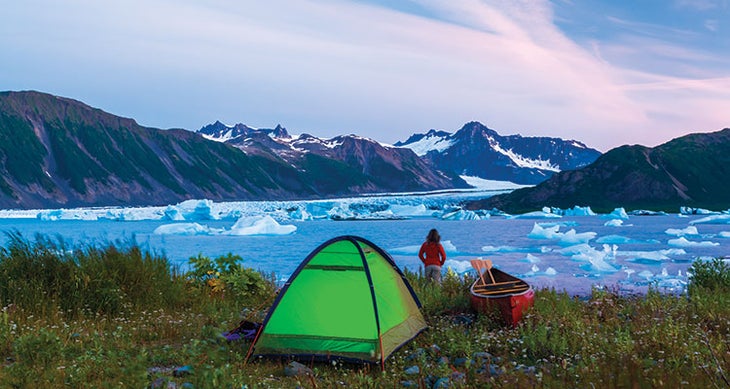
Last updated March 2022
